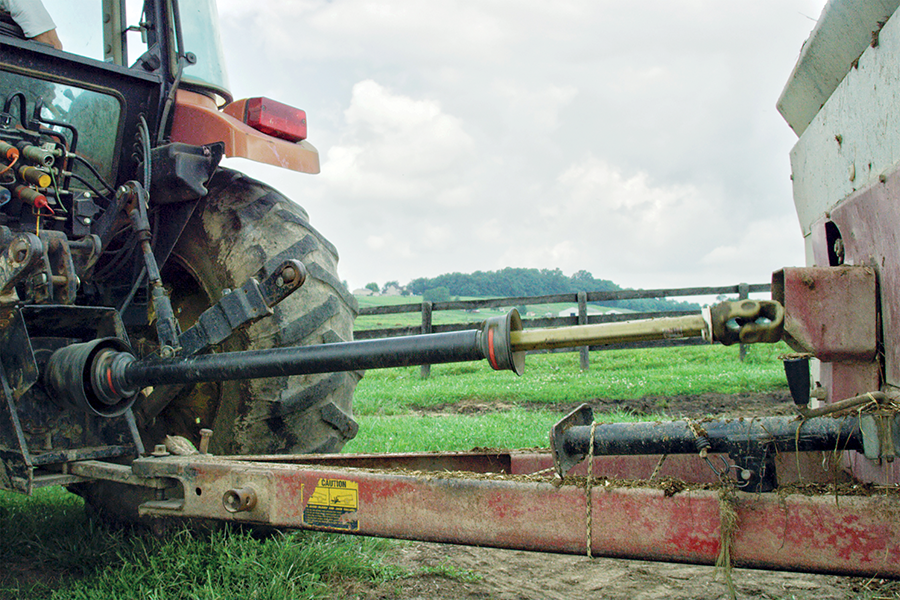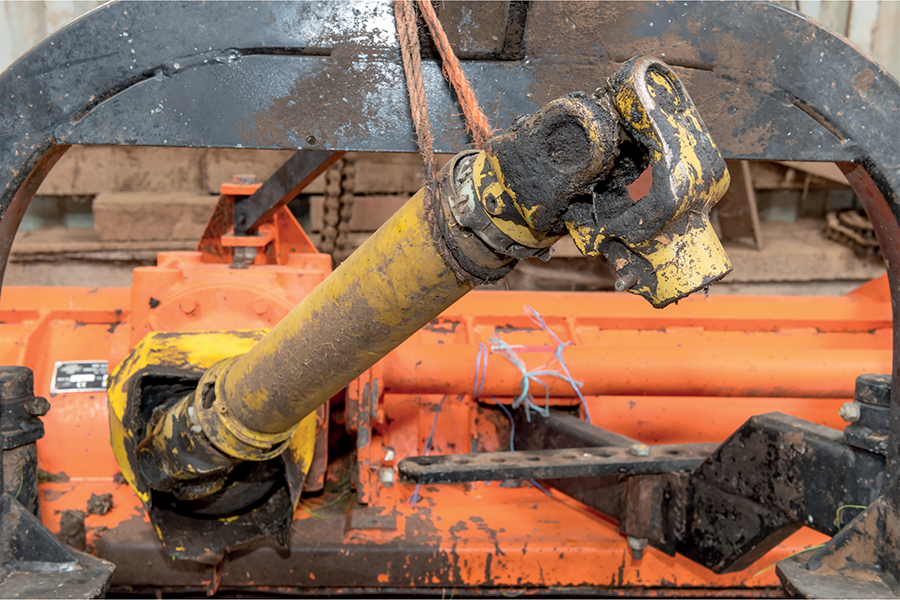Tips on PTO safety and maintenance to combat a major cause of farm accidents
26th November 2023
Accidents involving power take-off (PTO) shafts are among the most common causes of serious injury when operating farm machinery. To help raise awareness of PTO safety, Kramp, the agricultural spare parts supplier, has issued guidance to farmers to minimise the risk of an incident occurring and reduce PTO wear through proper set-up.

“Agriculture represents 1% of the working population but is responsible for 16% of all workplace fatalities,” says Farm Safety Foundation manager, Stephanie Berkeley. “It has the poorest safety record of any industry.
“Last year, three farm workers were killed when caught in machinery. An arm or a leg can be lost in an instant if it is caught in a PTO. One of our trustees lost a limb following an incident involving a PTO, so we have first-hand experience of the impact it can have.”
All PTOs should have an undamaged guard and chain in place. This requirement is covered within the Health and Safety at Work Act. However, it has been part of civil and criminal law for over 60 years, explains Stephanie. If an employee is involved in an accident and the appropriate measures have not been implemented, they are liable to be prosecuted.
“I have known cases of employers being jailed because of their negligence – all because they wouldn’t invest £75 in a new PTO guard. Employees must only use a machine if they have been adequately trained and all the safety measures are in place.
“If a farmer is unsure of the guidance, then we have a working with machinery guide on our www.yellowwellies.org website,” adds Stephanie.
No contest
“A strong person can generate about three-quarters of horsepower, whereas a tractor transmits nearly all of its horsepower into the PTO shaft,” says Kramp UK OEM specialist, Adam Hubbard. “There is no contest. If an entanglement occurs, a PTO shaft can wrap an arm or leg around it nine times in less than a second.”
The most crucial aspect of PTO safety is to ensure you start with the tractor. Ensure it is made safe, the handbrake is fully on, put all controls and gears in neutral, stop the engine and remove the key before working on a PTO. Most accidents involving PTOs happen because these steps are not followed. But it does not totally eliminate the risk even when they are, cautions Adam.
“I worked on a busy farm in Australia. There was a large group of us, and I followed these steps to maintain a tractor. Whilst underneath the machine, a colleague entered the cab, took the key from the seat and started the vehicle; I was lucky this was only a near miss.
“It is always best to maintain a PTO before and after it is last used, before taking a break, or at the end of the day. A quick visual check of the guard and the chain, and that it is sufficiently greased may be all that is needed most of the time. Also, check the PTO guard is secure to the PTO.
“I have a tip regarding the PTO guard chain, which most farmers do not do. It only takes 20 seconds and will save them time and money. When hooking up the chain, double it back through the D-link and hook it onto itself. This will shorten the chain length and prevent it from being wrapped around the guard tube. The guard should then only be able to turn 90 degrees with the available slack on the chain. A little more slack in the chain may be needed for a wide angle application, but if it is too much, it will wrap around the shaft and eventually wear through it, requiring replacement,” explains Adam.

New regulations for PTO connections
Farmers should be aware of regulation EN12965. This EU legislation came into force shortly before Brexit and was copied into UK law. Only collar locks are allowed on the primary drive shaft connected to the tractor. This means push-pin or certain collar locks with exposed springs are prohibited on new machines.
“Push pins may be used on second-hand machines, but it is imperative for new machines or repairs that an authorised collar lock is fitted. If a new machine is delivered, I recommend that a farmer check the compliance of the PTO connection. They can contact their local dealer or Kramp for advice if unsure which is legal for a replacement.
“The other statutory requirement that farmers should be aware of is for the PTO guard to overlap the joint by a minimum of 50mm when in a straight position. This ensures the guard covers the moving parts,” adds Adam.
How to correctly set up a PTO to reduce wear
The most common cause of PTO failure is an insufficient overlap of the PTO profile tubes. When the PTO is correctly installed, the overlap should be less than 33% longer than the shaft length. In practice, a closed shaft measuring 1,000mm should have a working length of less than 1,330mm. Adam recommends that the maximum closed centre length is at most 1,410mm due to vibration.
If the PTO is installed and there is not sufficient overlap, there will be excessive vibrations when the PTO is in operation. This will produce a whipping motion, which adds stress to the universal joint. The heat generated from this force can cause a catastrophic failure, endangering passers-by.
Adam urges farmers to refrain from using PTO adaptors on the main drive and to limit the maximum power they transmit to less than 30kW. An adaptor is an additional point in the drive line and causes excessive vibration. Instead, to be safe, he would recommend changing the yoke on the PTO to be suitable for the implements it needs to operate.
“One of the most common warranty claims is related to a single wide-angle application when the operator has used the PTO at an excessively wide angle. I have known brand-new PTOs to fail after only 10 hours of use when this happens. If exceeding this angle even briefly, a double wide-angle PTO may be needed.
“If there is a permanent working angle a wide-angle joint should not be used as it will prematurely fail due to lubrication. If such an angle is needed to operate the machine, it may be necessary to instal an H type joint.
“Another important consideration when setting up a PTO shaft to a machine is the vertical alignment of the PTO from the tractor to the machine. This can accentuate any horizontal alignment and produce oscillation when in operation. Z and W bends must be maintained as they will help prolong the service life of the PTO,” advises Adam.
All new operators using a tractor powering a PTO are fully briefed on PTO safety because otherwise, they may not know any different and how dangerous a PTO can be, declares Adam. More experienced operators should also be wary of complacency and treat a PTO seriously and with their full attention.
“Kramp is more than just parts. We have an expert team of experienced agricultural engineers, and several of us have also operated farm machinery, so we understand the practicalities. We support our dealers with bespoke training courses like PTO safety and can offer these to farmers on request,” concludes Adam.
Kramp Academy supports agricultural engineers
Utilising its in-house expertise, Kramp offers a series of courses to give agricultural engineers the confidence to work on specialist topics. They currently offer a one-day PTO course, a one-day hydraulics course and two BFPA-accredited hydraulics courses. Kramp Academy can take place at the Kramp head office in Biggleswade, or it can be done at a dealer’s site.
The Academy aims to ensure knowledge on the latest products, services and legislation is shared with the industry. The courses are constantly adapted to meet specific requirements and demands of the participants. More details can be found on the Kramp website.
